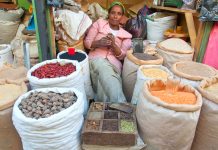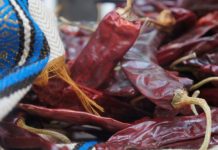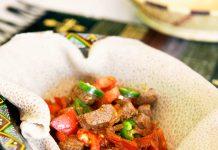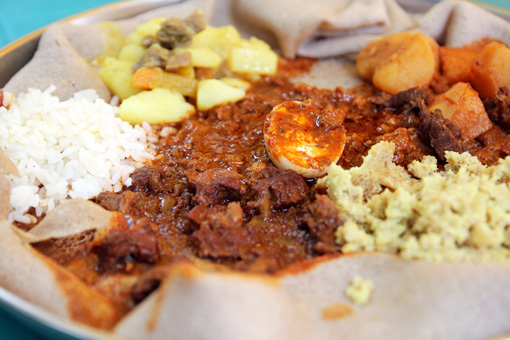
Ethiopian food is one of the most exciting cuisines in the world.
Not only is the food extremely unique and extraordinarily flavorful, but the food culture that makes up Ethiopia is also something I found truly fascinating.
To begin with, Ethiopian food is eaten with friends and family.
Even the way Ethiopian food is served, on a communal platter, is designed for sharing food with each other. Food is not meant to be eaten alone in the culture of Ethiopia. In fact, during my visit, I can’t say I ate off a traditional plate my entire time.
One thing I learned, by seeing it happen numerous times watching local Ethiopians eat, is that feeding someone a bite of food is seen as a very respectable or loving thing to do. I often saw couples tearing off pieces of injera, scooping up the best bites of delicious stew, and proceeding to feed it to their loved ones, a practice I soon learned is called gursha.
Taking the time to feed your loved one, or a friend you really care about, that just has to be one of the greatest culinary traditions that still exists today, anywhere.

How to eat Ethiopian food?
The very first thing you need to know about Ethiopian food is something called injera. Injera is the staple and the most widely consumed starch / filler in all of Ethiopian cuisine; Most Ethiopians eat it injera, twice, or even three times a day. It’s the foundation of Ethiopian food.
What is injera? Injera is made from a grain known as teff, which is ground into flour, made into a batter, slightly fermented, and then fried on a heavy skillet into a giant circular pancake. The texture is soft and spongy and the flavor is lightly sour.
When you go to an Ethiopian restaurant in Ethiopia, you order the dish, or mix of dishes that you’d like, and injera automatically comes with it – you don’t need to order it separately.
Food in Ethiopia is served on a platter known as a gebeta, a large circular, usually metal platter. First, a circle of injera is placed on the gebeta, then the different stews, curries, or vegetables, that you’ve ordered are placed on top of the injera. From a single dish to a mix of different dishes, everything is piled onto the plate of injera.
Depending on the restaurant, you might also get some extra rolls of injera (like in the photo pictured above) to begin eating with first, or alternatively you can immediately begin tearing off pieces of injera from the edges of the large main piece.
To begin eating, first tear off a bite sized piece of injera with your right hand. Then use it to scoop up, and pick up a bite of your choice of whatever you have on your platter.
As you begin to eat your dishes, you can begin to eat the foundation piece of injera at the bottom, and I think it’s the best part of the meal, because it’s had time to soak up all the wonderful flavors of the dishes.
No utensils are needed, you eat with your hands, while sharing a single platter of food with everyone you eat with.
Eating meals in Ethiopia is absolutely an amazing experience!

Seasonings and Flavors
Ethiopian food is well flavored with a mixture of different spices and herbs, not extremely spicy in heat, but rather very well seasoned.
The staple injera, mentioned above, is sour, and it goes well with the legume spicy riddled stews.
Berbere – Berbere is the masala of Ethiopian cooking, it’s a mixture of different spices that forms the backbone of flavor for many dishes. Chili powder, fenugreek, ginger, garlic, cardamom, cinnamon, and whole bunch of other spices are combined to make berbere. It’s essential in cooking Ethiopian food.
Mitmita – Mitmita is another similar blend of dry spices, but it’s often salty, and can either be used in cooking, or served as a side seasoning for meat. I especially like it with tibs (roasted meat).
Awaze – Awaze is the paste version of berbere. You actually get some berbere dry seasoning and mix it with oil (often olive oil), and a bit of Ethiopian wine or whiskey. It goes very well with meat dishes.
Niter kibbeh – Another highly important ingredient is niter kibbeh, or just Ethiopian butter. The clarified butter is brewed with some spices like fenugreek, cumin, and turmeric, so it has a lovely flavor to it. Basically if you’re not eating vegan Ethiopian food, your dishes will likely include some niter kibbeh in them.
These are a few of the main seasonings and spices that make Ethiopian food so incredibly flavorful.
Ethiopian vegetarian food
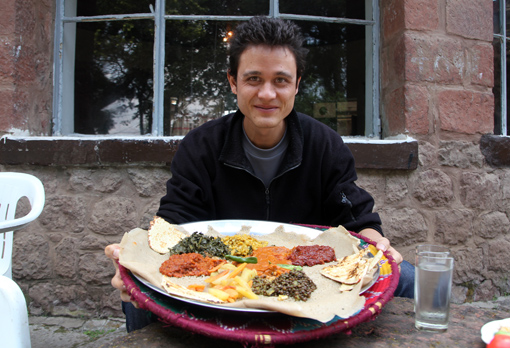
If you are planning to travel to Ethiopia and you’re vegetarian or vegan, you’re going to thoroughly enjoy yourself. I would definitely say, that if I ever had to become vegetarian, I would either live in India or Ethiopia.
Every Wednesday and Friday, as well as during the lent period each year for those who follow the Ethiopian Orthodox faith, are known as fasting days.
Now, this doesn’t mean not eating, it just means not eating anything that comes form an animal, or in other words only vegan food.
For the most part, when I was traveling in Ethiopia, I would eat vegan food on Wednesdays and Fridays as its commonly available at nearly all restaurants. It’s also quite common to find vegan food throughout the week as well, but you’ll find it widely available on those two days.
Also, be sure to check out my article on vegetarian Ethiopian food for more information.

10 Amazing Ethiopian Foods
There are plenty of wonderful dishes and variations of each dish to eat in Ethiopia, but here are ten dishes that I personally found to be widely available and extremely delicious.
When you travel to Ethiopia, don’t miss these foods.

1. Shiro wat
Along with injera, shiro wat, also just called just shiro, is one of the most widely consumed dishes in Ethiopia.
If you ever order a mixed combination platter of food (like yetsom beyaynetu), or if you eat vegetarian food, shiro wat will nearly always be among the selection.
Shiro wat is made from chickpea and broad bean flour, mixed with garlic and onions, and made into a thick, almost paste like substance. Kind of like refried beans but smoother. Non-vegetarian versions of shiro often includes lots of butter, but the vegan version usually includes a little olive oil instead.
I absolutely love shiro wat, especially like the version I ate multiple times at Grand restaurant in Addis Ababa, where it was infused with lots of garlic.

2. Misir wat
Another staple for the vegetarian repertoire of Ethiopian dishes is misir wat, or red lentil stew.
The lentils are cooked with a few spoons of berbere spice powder to give them a nice redness in color, and cooked until tender, yet they still have some texture to them.
When I was in Ethiopia, I ate misir wat at many restaurants, and every time, it tasted just slightly different. Could be due to the amount of spices they used, or how long they cooked it, sometimes the texture was smoother and sometimes more whole lentils. It was always good, but always a little different.

3. Salata (Ethiopian salad)
Believe it or not, salad proved to be one of my favorite dishes in Ethiopia, especially the timatim salata, or tomato salad.
The tomatoes were always fresh and crisp, with so much flavor to them. The tomatoes were diced, mixed with some onions and chilies, and seasoned with salt, lemon juice, and a drizzle of olive oil.
I think it was both the fresh flavorful vegetables paired with the injera, and sort of mixing up each bite with another curry, and that contrast of the tomato lemony salad that made it taste so good.
I ate tomato salad at many restaurants while traveling in Ethiopia and never had stomach problems.

4. Chechebsa (kita fir fir)
There aren’t too many Ethiopian breakfast dish varieties available, but one of the common things to eat in the morning, or even for lunch, is chechebsa, made from kita bread.
For myself, I actually normally preferred a slab of injera and some meat curry for breakfast, but chechebsa was also quite tasty from time to time.
Imagine a paratha (a flaky oily fried bread) shredded into bite sizes pieces, then fried up with some butter and just a hint of berbere for flavoring.
When I ate chechebsa in Ethiopia, it was served with a side of fresh honey and a bowl of plain yogurt. The contrast of the oily spicy doughy bread with sweet honey and yogurt was unique and flavorful.

5. Injera fit fit (fir fir)
Fit fit or fir fir is normally made with leftover or day old injera, mixed with leftover stew, such as shiro wat. The injera is torn into small bite sizes rolls or pieces, marinated in the leftover stew of the day, and left in the fridge overnight.
The injera pieces in fit fit or fir fir become really moist and fall apart, quite sour, and also very juicy. The sponginess of the injera soaks up a lot of liquid. It’s served cool, sometimes even with ice cubes in it.
It’s definitely an interesting dish to try in the Ethiopia food list, and at first it didn’t look all that appealing, but once I tasted it, I really enjoyed it!

6. Doro wat
One of the great Ethiopian foods is doro wat, or chicken stew. When I first tried Ethiopian food, back when I was living in Nairobi, when I was about 12 years old, I think my first bite was doro wat.
I’ve been in love with it ever since.
Using the omnipresent mixture of berbere spices, a heavy load of Ethiopian butter, chicken, eggs, and onions, doro wat is born. The sauce is mostly made from onions that have been stewed down for so long, they disintegrate into a puree.
The chicken comes dripping with juices and the egg is caked in flavor. The best doro wat I had was at Kategna restaurant in Addis Ababa.

7. Key wat
Key wat is a fantastic Ethiopian beef stew.
The meat is usually cut into tiny cubes, then stewed with a generous amount of red berbere seasoning, some extra cumin, fenugreek, onions, garlic, and a bit of tomato puree to make the sauce.
The meat and sauce combination of key wat makes for the perfect dish to mop up all the flavorful sauces and juices. The bottom of the injera, at the end of your meal, is always packed with flavor.

8. Gomen be siga
Gomen is a popular vegetarian dish, mostly just collard green fried up with some butter. It’s really good as a vegetarian dish, but even better when it’s mixed with some extra garlic, diced pieces of beef, and some extra vegetables, known as gomen be siga – and it’s no longer vegetarian.
It’s not always served in a hot clay vessel, but it sometimes is, and it was really delicious the time I got it. You can either spoon out scoops of collard greens and beef onto a piece of injera, or you can dig right into the bowl.

9. Kitfo
Kitfo, a dish made from raw minced beef, is one of the most beloved local dishes in the entire country. It’s a food that’s often eaten on special occasions, with good friends or family.
You can either order leb leb, which is very slightly cooked, or the normal kitfo which is completely raw. The minced meat is mixed with mitmita, a blend of spices, and niter kibbeh, the Ethiopian herbed butter, and that’s it.
The meat is served with injera, and at a nicer restaurant I also got a bread called kocho.

10. Derek tibs
Despite there being plenty of vegetarian food available in Ethiopia, if you’re a meat lover, many Ethiopians are also in love with meat.
Walking along the streets of Addis Ababa, you’ll get whiffs of freshly butchered meat, hanging in the open air butchery ready to be sliced off and served by the chunk.
Step into a butcher and you can order a straight up hunk of raw beef served with a dipping sauce, but I especially liked roasted meat, known as derek tibs. You can normally choose between beef or goat, and the meat is sliced up into pieces, fried with butter, and served inside a flaming hot ceramic dish.
Derek tibs is sometimes also seasoned with rosemary and garlic, and served with awaze, a chili dipping sauce on the side, and rolls of injera.
If you love meat you’ll love derek tibs.
Finally, I just wanted to mention that Ethiopian food is especially wonderful when you get to eat a mixture of different dishes in one meal or on one platter.
So I often ordered either a mahaberawi, which is normally a mixed platter including meat dishes, or the yetsom beyaynetu, which is a mix of different vegetarian dishes.

What to drink in Ethiopia
Ethiopian coffee
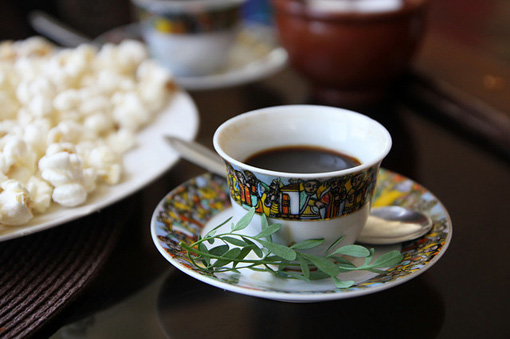
If you love coffee, you already know that Ethiopia is the birthplace of this wonderful beverage. When I was in Ethiopia, I could not get over how delicious the coffee was and hot readily available it was as well.
Buna is the traditional Ethiopian style of coffee, prepared in a clay pot known as a jebena, and served in small espresso cups. Other types of European style coffees, like macchiatos, are also commonly available at restaurants and coffee shops.
I liked every kind of coffee in Ethiopia, but one of my favorite memories was stepping into a hole-in-the-wall coffee shop where a lady was roasting beans, grinding the coffee, and brewing it fresh. You’ll find local Ethiopian coffee all over the place.
Fruit smoothie shakes
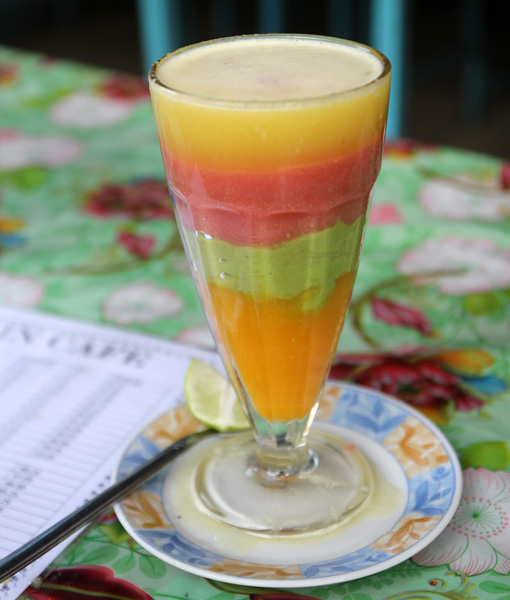
I normally don’t intake too many drinks, for no better reason than I like to eat and fill up on meals rather than beverages. But in Ethiopia, I could not resist myself from the amazing juices, which are actually more like thick smoothies.
Pure avocado juice, or the mixed fruit which came layered with different blended fruits, were my favorites. What I really liked about Ethiopian juices, is that they used only a hint of sugar (or no sugar if you asked).
Can’t beat an Ethiopian avocado juice!
Ethiopian food videos
Watch all Ethiopia videos here.
Ethiopian food is growing in popularity outside of Ethiopia, especially in the United States where I’ve eaten it numerous times, and even there are a couple of Ethiopian restaurants in Bangkok.
I had an incredible time in Ethiopia, and really enjoyed tasting this amazing complex and culturally significant cuisine.
Source: Migrationology
By Mark Wiens






















